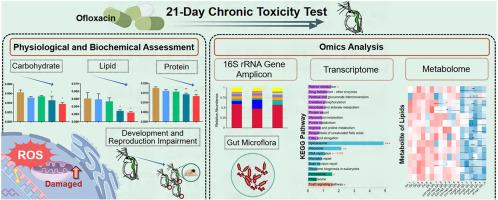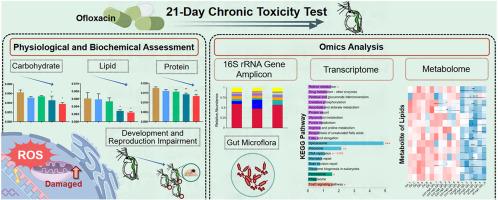氧氟沙星对大水蚤慢性毒性的机制:氧化应激、线粒体功能障碍和能量分配
IF 7.3
2区 环境科学与生态学
Q1 ENVIRONMENTAL SCIENCES
引用次数: 0
摘要
氧氟沙星(Ofloxacin, OFL)是一种氟喹诺酮类抗生素,由于其广泛使用和频繁的环境检测,对水生系统造成了生态风险,引起了人们的关注。本研究采用21天的慢性试验,对大水蚤生态毒理学模型进行了OFL(0.01、0.1、1和10 mg/L)的多级生态毒性评估。涉及的参数包括线粒体功能、代谢物、消化酶、氧化应激、发育、繁殖、运动行为和多组学分析。环境相关浓度的OFL (0.01 mg/L)暴露对大鼠氧化还原稳态、肠道菌群和脂质代谢产生不利影响。值得注意的是,暴露于OFL的大鼠的生殖能力出现了激效效应。此外,暴露于高浓度的OFL污染(0.1、1和10 mg/L)会导致大鼠明显的氧化应激,导致肠道损伤,消化酶和代谢物减少。值得注意的是,暴露于10 mg/L的OFL会导致大鼠线粒体功能障碍和脂质代谢物短缺,导致能量供应破坏,运动、发育和繁殖受损。本研究全面评估了OFL的水生生态风险,揭示了OFL对大鼠d.m arna发育、繁殖和能量分配的毒性机制。本文章由计算机程序翻译,如有差异,请以英文原文为准。


Mechanisms underlying the chronic toxicity of ofloxacin to Daphnia magna: Oxidative stress, mitochondrial dysfunction, and energy allocation
Ofloxacin (OFL), a fluoroquinolone antibiotic, has attracted attention due to its extensive use and frequent environmental detection, posing ecological risks in aquatic systems. Herein, a multilevel ecotoxicity assessment of OFL (0.01, 0.1, 1, and 10 mg/L) was conducted on an ecotoxicology model, Daphnia magna, using a 21-day chronic test. The involved parameters included mitochondrial function, metabolites, digestive enzymes, oxidative stress, development, reproduction, locomotor behavior, and multi-omic analysis. Environmentally relevant concentration of OFL (0.01 mg/L) exposure elicited detrimental effects on redox homeostasis, intestinal flora, and lipid metabolism in D. magna. It is noteworthy that hormetic effects were observed in reproductive capacity in D. magna exposed to OFL. Furthermore, exposure to elevated contamination concentrations of OFL (0.1, 1, and 10 mg/L) led to pronounced oxidative stress in D. magna, resulting in gut damage and reduced digestive enzymes and metabolites. Notably, exposure to 10 mg/L OFL induced marked mitochondrial dysfunction and shortage of lipid metabolites in the D. magna, leading to the destruction of energy supply and impairment of locomotor, development, and reproduction. This study comprehensively assessed the aquatic ecological risks of OFL and provided insights into the mechanisms underlying the toxicity of OFL on the development, reproduction, and energy allocation of D. magna.
求助全文
通过发布文献求助,成功后即可免费获取论文全文。
去求助
来源期刊

Environmental Pollution
环境科学-环境科学
CiteScore
16.00
自引率
6.70%
发文量
2082
审稿时长
2.9 months
期刊介绍:
Environmental Pollution is an international peer-reviewed journal that publishes high-quality research papers and review articles covering all aspects of environmental pollution and its impacts on ecosystems and human health.
Subject areas include, but are not limited to:
• Sources and occurrences of pollutants that are clearly defined and measured in environmental compartments, food and food-related items, and human bodies;
• Interlinks between contaminant exposure and biological, ecological, and human health effects, including those of climate change;
• Contaminants of emerging concerns (including but not limited to antibiotic resistant microorganisms or genes, microplastics/nanoplastics, electronic wastes, light, and noise) and/or their biological, ecological, or human health effects;
• Laboratory and field studies on the remediation/mitigation of environmental pollution via new techniques and with clear links to biological, ecological, or human health effects;
• Modeling of pollution processes, patterns, or trends that is of clear environmental and/or human health interest;
• New techniques that measure and examine environmental occurrences, transport, behavior, and effects of pollutants within the environment or the laboratory, provided that they can be clearly used to address problems within regional or global environmental compartments.
 求助内容:
求助内容: 应助结果提醒方式:
应助结果提醒方式:


